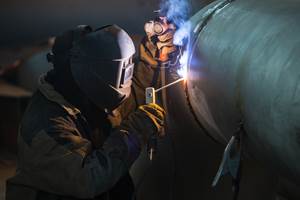Helping Machine Operators with Math
Requiring machine operators to perform calculations repeatedly has a negative impact on productivity.
Any time you see a machine operator or setup person using a calculator, pay attention: There is probably something you can do to help them and improve productivity. With all we expect of these people, why add to their work? Performing calculations takes time and can sometimes lead to mistakes and scrapped parts. Plus, a machine might sit idle while a calculation is performed, which can add to the time it takes to complete a setup or production run.
Suggestions for facilitating or eliminating calculations fall into the category of task simplification. I regularly hear managers start a sentence with, “A good operator should be able to...” and then complete the sentence with just about any imaginable task, regardless of its complexity or time-consuming nature.
A math-related completion to this sentence might be, “A good operator should be able to calculate values needed for program-zero assignments.” Other tasks include calculating a thread’s pitch diameter after measuring over pins, calculating the speed and feed for a cutting tool, calculating the depth of a through hole and calculating the angle of taper on a workpiece.
The list continues. While a good operator should be able to perform these calculations, why would we want them to? This is especially true if it takes time and introduces the potential for mistakes. If there is a way to facilitate or eliminate these calculations, find it and implement it. Doing so will, at the very least, save production time. More likely, it will reduce the number of mistakes and minimize their impact on production.
So, when do you see your machine operators reaching for calculators? Is it every setup or every cycle? The more times the calculation is repeated, the bigger impact that facilitating or eliminating the calculation will have. You must find realistic, feasible and appropriate ways to facilitate or eliminate the time-consuming calculations your machine operators make.
For example, maybe you have a bar-fed turning center and the setup person must calculate how many workpieces can be run from each bar and how many bars must be run to complete an order. Eliminate the calculations by incorporating a part-counting custom macro that enables a simple entry for the number of workpieces to be produced. The custom macro will stop the cycle once the final part count has been achieved.
Maybe your machine operators primarily work in the metric system but must sometimes work in the imperial system. Find ways to keep them from having to perform any conversions between measurement systems. For example, utilize electronic measuring tools that can be easily set and calibrated for either measurement system mode. Incorporate programs that fully utilize the measurement system mode being used. That is, do not run workpieces dimensioned in the metric system with a program that has been written using the imperial system with converted coordinates. That way, all offsets can be specified in the measurement system originally used to dimension the part.
If you expect your machine operators to occasionally perform trigonometry calculations, find ways to help. A custom program on a mobile device could enable operators to input known values and receive the needed answers without performing the calculations themselves. For example, the machine operator may be measuring workpieces on a surface plate using a sine bar. Develop the needed calculation in a tablet or computer program that enables the operators to easily enter their measured value/s and make the mobile device respond with the answers they were previously calculating.
These are but a few suggestions. As you walk the shop floor, look for operators using calculators. Then, be aggressively aware. Is there anything you can do to help? Given the potential for improving productivity, do not be too quick to say no.
Indeed, good operators may think that simplifying calculation-related tasks is “dumbing down” the work they do and resent it. To a point, they are correct. Simplified tasks can be performed by people of lower skill levels. Make it clear that your goal is to free up some of their time, possibly so they do not have to work so hard to get their work done, or possibly so they have time to complete other, more important tasks.
Related Content
Selecting The Right Welder
Many machine shops, on occasion, have a need for welding. It may be for maintenance purposes, repair or to fill the odd contract. This story is a welding process primer for those shops whose main business isn't welding but need to know some basics.
Read More6 Steps to Take Before Creating a CNC Program
Any time saved by skipping preparation for programming can be easily lost when the program makes it to the machine. Follow these steps to ensure success.
Read MoreUnderstanding Swiss-Type Machining
Once seen as a specialty machine tool, the CNC Swiss-type is increasingly being used in shops that are full of more conventional CNC machines. For the newcomer to Swiss-type machining, here is what the learning curve is like.
Read MoreUnderstanding The Four Major Behavioral Styles
Companies today are expanding the role of teams in the workplace in an effort to empower employees and improve organizational effectiveness. The more we try to work as a team, the more important it becomes to recognize that people exhibit different behavioral styles.
Read MoreRead Next
3 Mistakes That Cause CNC Programs to Fail
Despite enhancements to manufacturing technology, there are still issues today that can cause programs to fail. These failures can cause lost time, scrapped parts, damaged machines and even injured operators.
Read MoreThe Cut Scene: The Finer Details of Large-Format Machining
Small details and features can have an outsized impact on large parts, such as Barbco’s collapsible utility drill head.
Read More
.jpg;width=70;height=70;mode=crop)

























